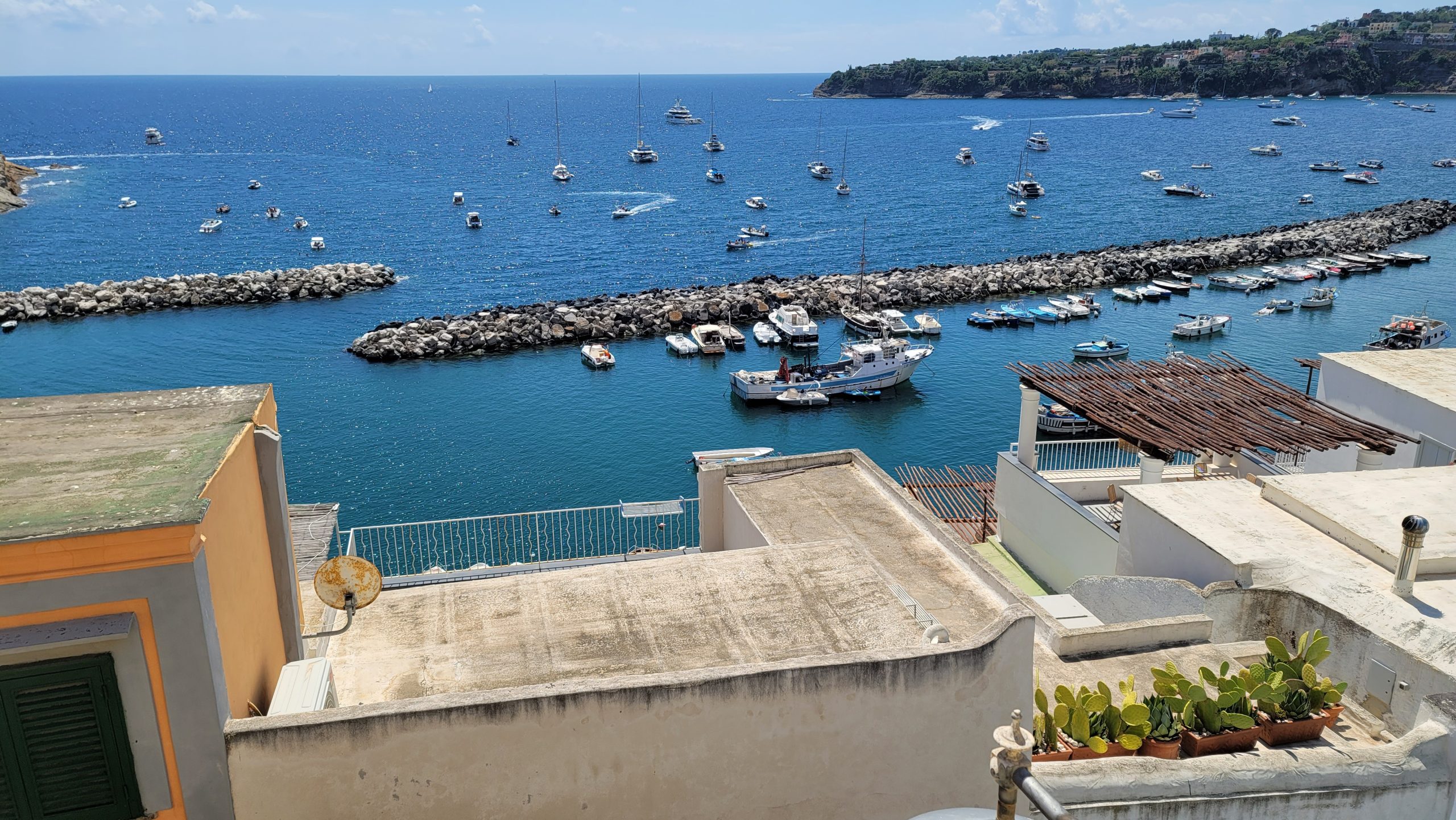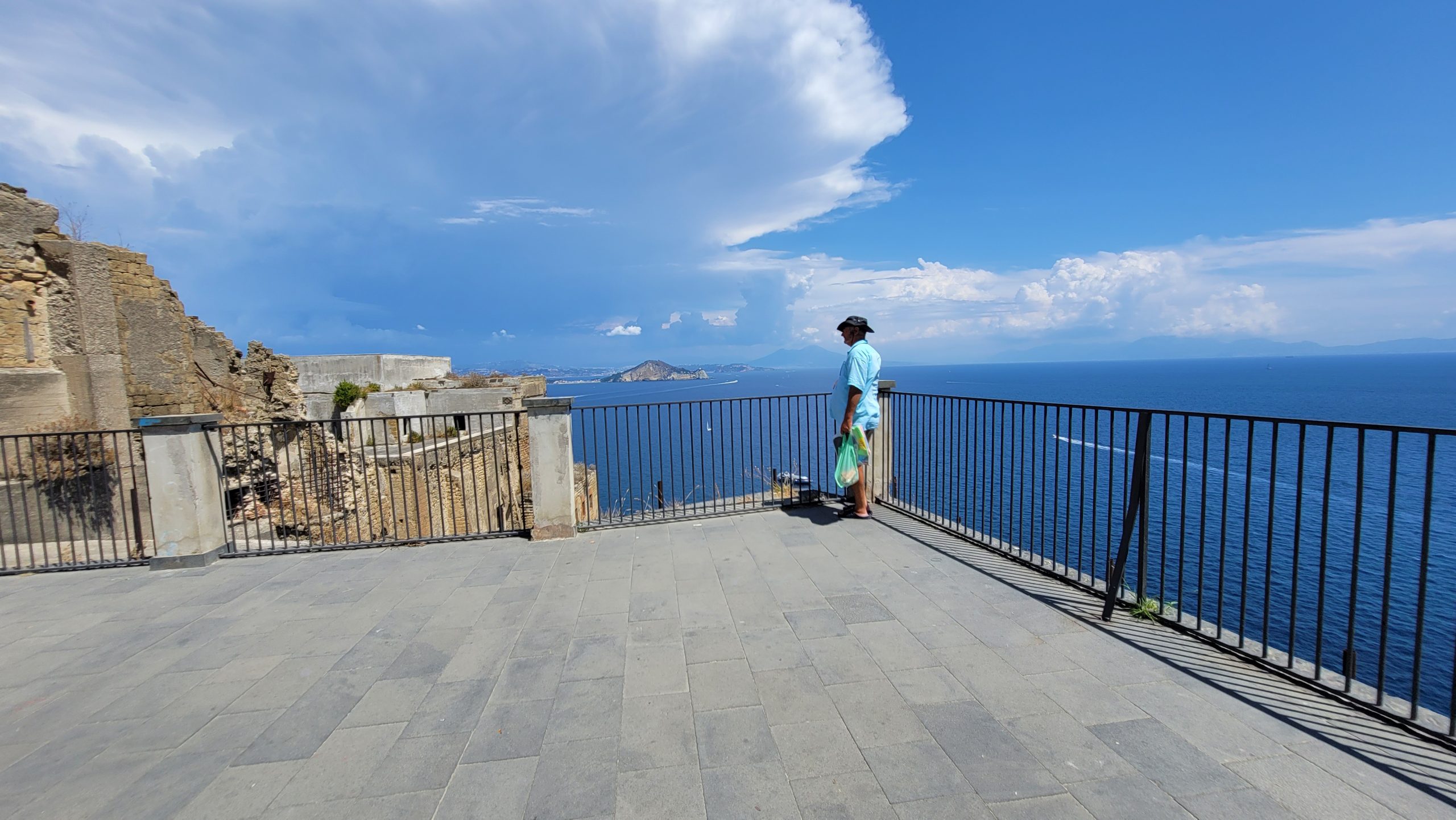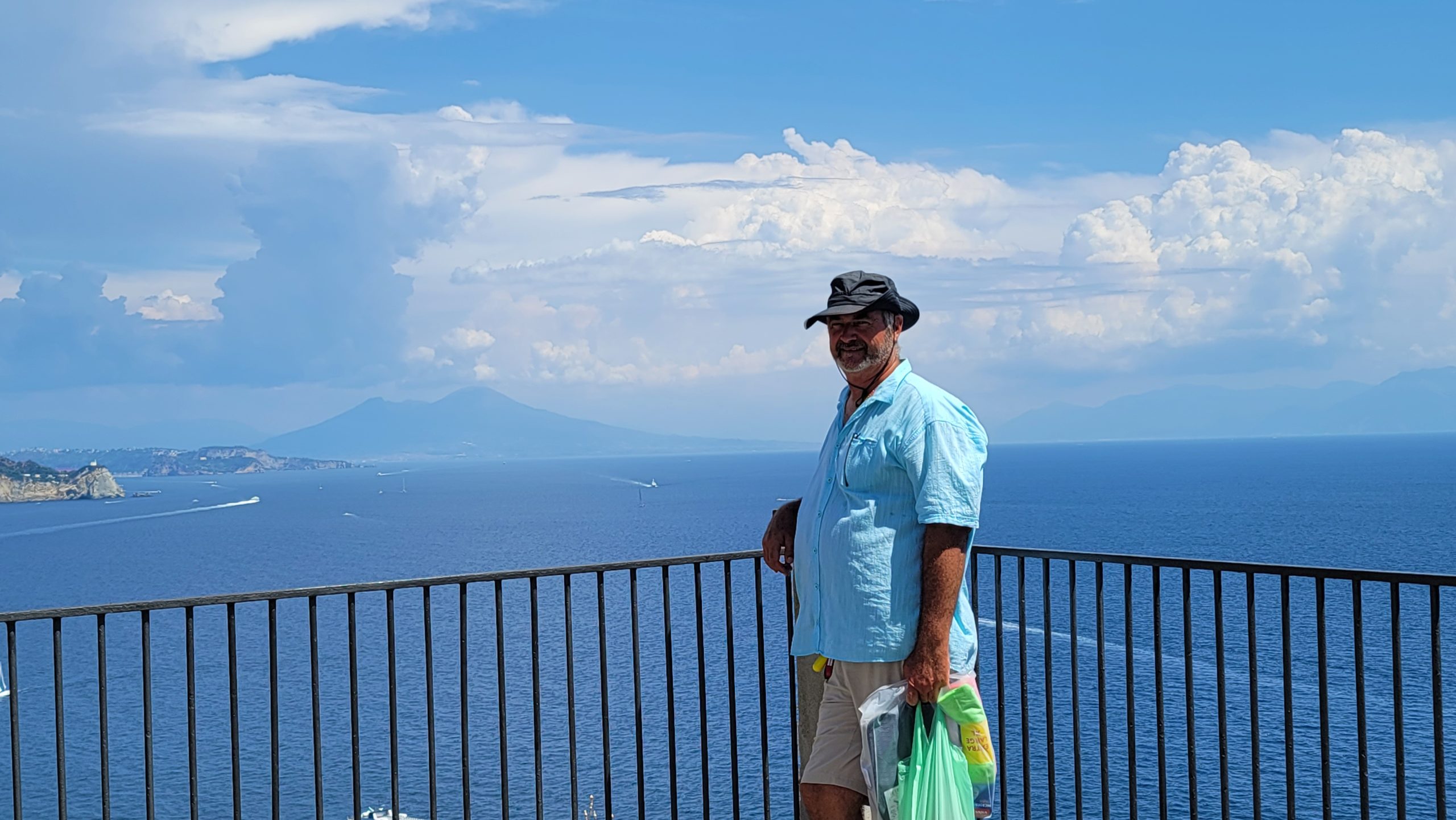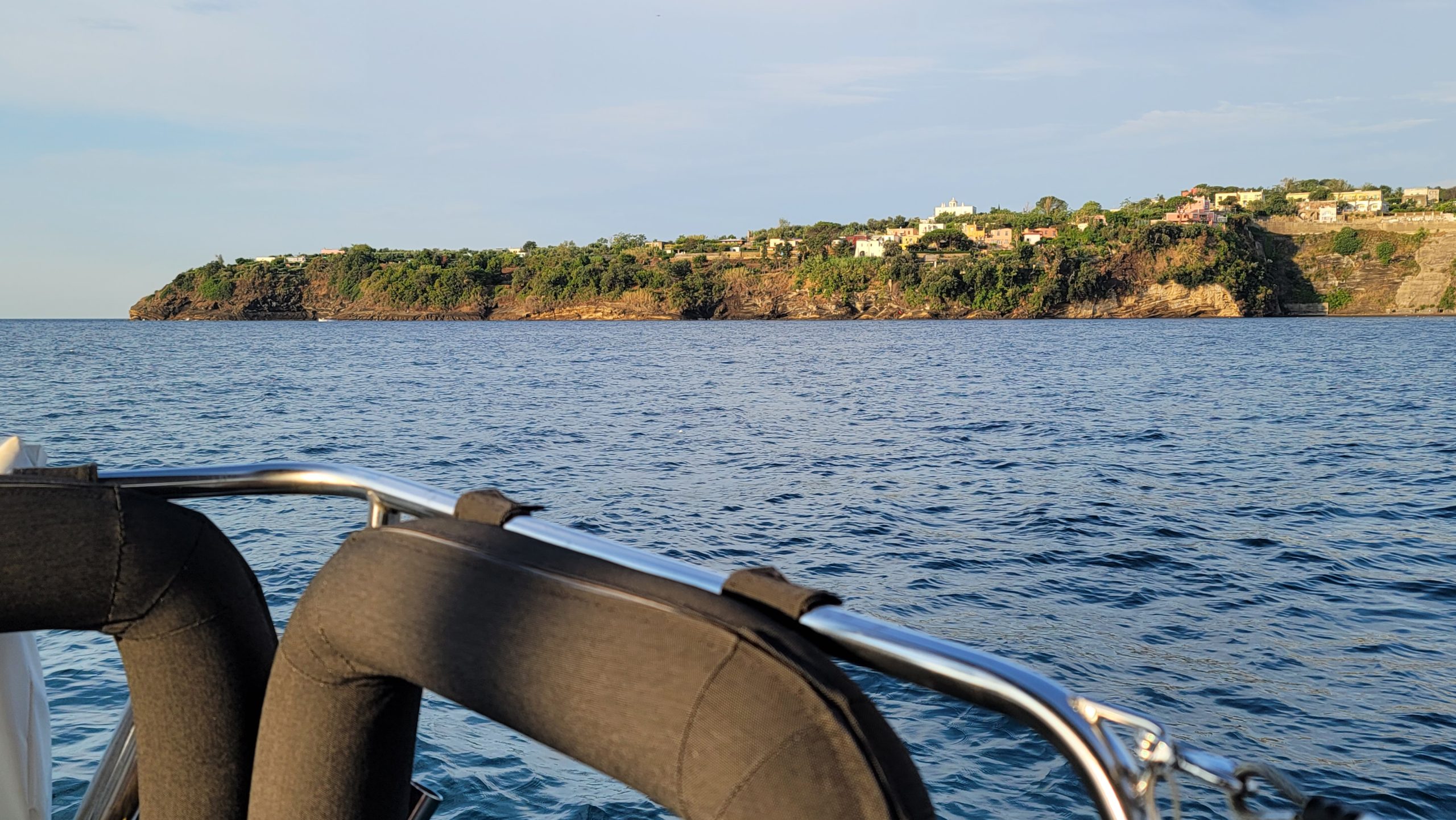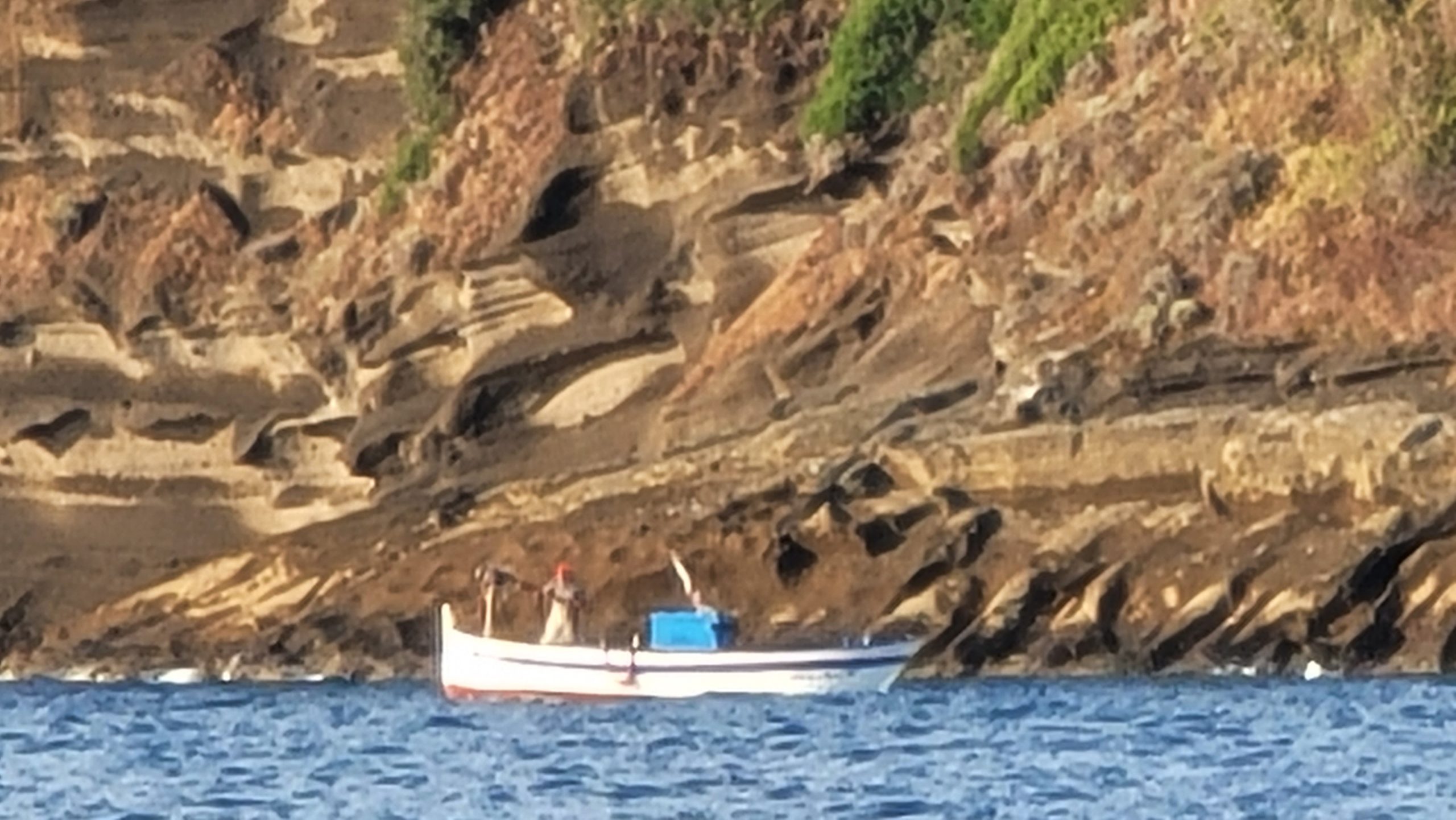We should have read the weather better. All of the signs were there. We were just stupid enough to ignore them.
Large rapidly forming cumulus building and coming our way. They were in all the photos we took, but we didn’t see them as we concentrated on getting Vesuvius in the background and not the clouds as much. Large beautiful white fluffy clouds did look great in the photos, but they were harbingers of dangerous deteriorating conditions to come.
We were anchored in the northern part of the bay close to the town and the forecast suggested that the wind intended to turn west, and we looked down to the southern end of the bay. We saw a few boats in that area and in shelter so we decided to join them. We upped anchor, motored down, got a good spot and set the anchor at 1800rpm in reverse. The anchor set with that amount force should hold in almost any weather conditions. Daylight was just starting to fall, and only a bit of twilight remained. We saw lightning and heavy rain to the east but no thunderstorms have been forecast from that direction so we enjoyed the show.
We realized that soon the storm would hit us and hit us hard. We were now in an unsheltered area with about 6 boat lengths of cliffs on Punta Pizzaco behind us. Not good!
We put on our foul weather gear and turned on the helm and started the motor and it didn’t take long before it crashed into us. The force of the rain drove the water right through the fabric of my sail jacket. In less than a minute I was completely sodden and cold. Freezing, using the motor I fought to keep the bow of the boat to the wind and seemed to maintain control until the bow and boat went sideways against the wind. How could this be after such a good set???
It seemed our anchor was dragging. Hell, did I move too far forward and trip it? Did it lift on the bounce of a wave? Something else happen to it? We had to bring up the anchor in the storm and move the boat to where we were before in the northern part of the bay where it now is more sheltered. No other option.
Karin clipped her tether on and went forward to raise the anchor. Meanwhile, the wind was screaming, and the boat was crashing up and down due to the building waves. The waves were being driven higher and higher by the storm. Karin came back alarmed ‘Windlass doesn’t work, doesn’t go up and doesn’t go down. No power to raise the anchor. Seems burned out’. Shit, shit, shit! … all the while, we are dragging back to the rocks behind us. ‘Karin quick take the wheel’. I rushed down below to where the circuit breakers were, and hoped that a fuse had tripped and it was nothing more than that. It had tripped, and I reset it. Back at the helm I asked Karin again to raise the anchor. She went forward. And this time, the windless worked and the anchor started to come back up. I don’t know how she was staying on deck with the driving rain and the heaving bow.
Karin rushed back. Peter, we had a problem. What now? We have a fishing net tightly wrapped around the anchor and chain. Damn, damn, damn. Now we have no anchor to hold us trapped in a fishing net that we cannot motor forward on otherwise we would foul the propeller in the fishing net and that would be it. No matter. And we would soon be on the rocks that we are now only two boat lengths behind us.
continued below …
Panic in Procida!
Luckily, I had put a 6 inch fixed blade sport knife in one of the helm bins. I quickly fetched it and gave it to Karin. Five minutes later, Karin came back from the bow. ‘My arms are not long enough, and I’m not strong enough to cut the lines of the net on the anchor dangling at the end of the bow’. The wind was still shrieking and the rain was horizontal. Waves were crashing up and down against the hull. There is now almost no light. The boat about 50 meters from the rocks. And I was totally cold and soaked to the bone. Time to switch rolls. Karin took the helm, and I took the knife forward. We were both tethered when we went to the bow but if either us got thrown over this side the other person would not be able to leave the helm to help us get the persopn back on board. If we put the auto pilot on, we would likely run over the net, foul the propeller and stop the engine.
It was hard to get to the anchor and net wrapped around it, even with long arms. The furled genoa and forestay was in the way. The windlass was in the way. The pulpit was in the way. I managed a slide sideways with my hips between Pushpit and Genoa and lay on the bow roller. I could just manage to reach the anchor and with the knife in hand saw at the mass of netting and rope. Half a dozen synthetic lines from the net formed a knot along with the tangle of red netting itself. All twisted like a braid. I started with the lines and sawed and sawed until they dropped free. Then came the actual net, which seemed slippery and spongy and hard to cut. The best way was to force the blade upside down into the mass and use the pressure of the tangle against itself and try and cut knife edge up.
There was very little light in the day and we had already turned on the bow flood lights to make it easier for other boats to see us and avoid us. This proved beneficial as it also allowed us to see what I was doing. Finally, the tangle of netting and ropes fell off the anchor below the bow into the darkness. We were free. We just better not foul our propeller passing over it! I yelled out to Karin that we were free and tried to get up to go back to the cockpit but I was stuck! I was wedged in there so tight, and with my PFD, it made me more stuck.
The top half of my body was still hanging down over the bow of the boat where I could reach the anchor. There was no way I could remain there with the wind and waves as they were and there was only one way to get free and do too bad if the PFD got broken or ripped. Too bad if my sail jacket got ripped, too bad if I broke a rib.. I had to get back to the cockpit and away from the bow. While slamming up and down into each wave I just pushed and pushed and pushed up off the deck and could feel my PFD grabbing, but didn’t care. Stomach and ribs hurting more. One more push, and I was free!
I got back to the cockpit, and we made our way to the other sheltered end of the bay where we had been previously, dropped the anchor with an 8 times scope this time and set it to 1800 RPM in reverse and rested. The chart plotter read maximum wind speed of 46.3 knots.
Lesson learned?
- Do not trust the weather forecast as being perfect and dependable.
- Plan for what if 180 degrees. ie. what if the weather forecast is 180 degrees wrong. What would happen? Where would you be? And what would you do?
We ended up taking a photo of the poor fisherman pulling in his demolished nets the next morning. It’s a shame, because that was his livelihood, and we destroyed his nets. However the boat and crew were safe and undamaged and we didn’t hilt the rocks behind us. We were lucky.


